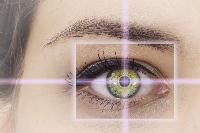Manufacturer of high-quality measuring tools
Laser classes according to DIN EN 60825-1
Recommendations for the safe handling of rotating lasers, line lasers and positioning lasers
The safety regulations according to EN 60825-1 are binding for measuring devices with laser radiation. Most laser leveling devices are classified in laser class 2 or 3R. Rotation lasers and positioning lasers in particular are often classified in laser class 3R and should not be purchased without due consideration. We have derived some recommendations for you from this.

Laser können das Auge schädigen.
Foto: hikmetyildiz (iStock) |
|
![]()
|
|
![]()
|
Laser class 2
This class mainly includes rotation lasers, line lasers and laser distance meters. The laser radiation emitted is low and the eye is sufficiently protected by the natural defense reaction.
A prolonged look into the beam should be avoided.
![]()
|
|
![]()
|
|
![]()
|
Laser class 3R
The laser radiation is many times higher than in class 2. Looking directly into the laser beam can be dangerous.
Class 3R lasers should only be used under conditions where direct viewing of the beam is unlikely.
The devices may only be used in a controlled working environment. For example, in closed rooms and workshops. Access to the beam area must be restricted to instructed persons.
![]()
|
|
![]()
|
|
![]()
|
Rotary laser with class 2 or 3R?
Rotation lasers have a point prism and generate a laser line by rotating the laser head. It is therefore impossible to look into the laser beam for any length of time. Under these conditions, the use of class 2 and 3R rotating lasers is safe.
However, random reflections can occur outdoors due to mirrors and glass surfaces. It is therefore not advisable to operate a class 3R rotating laser outdoors.
On construction sites or company premises, the responsible laser safety officer can make use of his domiciliary rights and prohibit tradesmen from operating class 3R rotating lasers.
With our Q3 and Q3G rotating lasers, you can switch between laser classes 2 and 3R and thus work in the laser class that is best for you. This allows you to use the better visibility of laser class 3R in the controlled environment of interior work and switch to the unproblematic laser class 2 on larger construction sites or in outdoor areas.
![]()
|
|
![]()
|
|
![]()
|
Repairs only by qualified personnel
The laser radiation is measured outside of the device for classification into a laser class. In other words, where it can cause damage to the eye. Inside a rotary laser, line laser, laser distance meter or positioning laser, the laser radiation can be significantly higher. For this reason, protective covers or housings should only be opened by qualified personnel.
With our repair and calibration service, we offer you cost-effective maintenance of your devices at a flat rate. And for many years after purchase and over the entire expected service life.
![]()
|
|
![]()
|
|
![]()
|